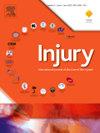Increasing incidences of acetabular, pelvic fractures and proximal femur fractures in the Netherlands
IF 2.2
3区 医学
Q3 CRITICAL CARE MEDICINE
Injury-International Journal of the Care of the Injured
Pub Date : 2025-04-02
DOI:10.1016/j.injury.2025.112322
引用次数: 0
Abstract
Purpose
This study aims to investigate incidence rates of acetabular, pelvic, and proximal femur fractures in the Netherlands over a 10-year period (2012-2022). With an aging population, understanding trends in these osteoporotic fractures is essential for improving patient outcomes and guiding healthcare strategies.
Methods
A retrospective cohort study was conducted using data from two national databases, forming a ‘hospitalised’ and an ‘all patients’ cohort. The study population included patients diagnosed with acetabular, pelvic, and proximal femur fractures in the Netherlands during the study period. Incidence rates were calculated per 100,000 person-years and linear regression was used to assess temporal trends. Age-adjustments were performed using Dutch population data from the Central Bureau of Statistics (CBS). Comparative analyses between the two cohorts were conducted to identify discrepancies.
Results
A total of 283,991 patients were identified (12,020 acetabular, 70,595 pelvic and 201,376 proximal femur fractures). Of these patients, 159,563 were hospitalised (7,123 acetabular, 24,192 pelvic, and 128,252 proximal femur fractures). Incidence rates of acetabular fractures increased by 26% (hospitalised) and 98% (all patients), while pelvic fractures showed stagnation in hospitalised patients (-0.13%) but a 44% rise in all patients. Proximal femur fractures increased by 5% (hospitalised) and 15% (all patients). Significant differences between the databases were noted across all fracture types.
Conclusion
The incidence of acetabular, pelvic, and proximal femur fractures has significantly increased in the last decade, most notably in acetabular and pelvic fractures. Furthermore, a shift toward out-patient treatment of acetabular and pelvic fractures was found. These findings highlight the need for improved fracture prevention and out-patient management strategies, while also underscoring the need for a nationwide registration for these injuries.
求助全文
约1分钟内获得全文
求助全文
来源期刊
CiteScore
4.00
自引率
8.00%
发文量
699
审稿时长
96 days
期刊介绍:
Injury was founded in 1969 and is an international journal dealing with all aspects of trauma care and accident surgery. Our primary aim is to facilitate the exchange of ideas, techniques and information among all members of the trauma team.

 求助内容:
求助内容: 应助结果提醒方式:
应助结果提醒方式:


